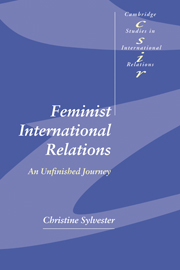Book contents
- Frontmatter
- Contents
- Acknowledgments
- Part I Introduction
- Part II Sightings
- 3 Handmaids' tales of Washington power: the abject and the real Kennedy White House
- 4 Reginas in international relations: occlusions, cooperations, and Zimbabwean cooperatives
- 5 The White Paper trailing
- 6 Picturing the Cold War: an eye graft/art graft
- 7 Four international Dianas: Andy's tribute
- Part III Sitings
- Part IV Citings
- References
- Index
- CAMBRIDGE STUDIES IN INTERNATIONAL RELATIONS
3 - Handmaids' tales of Washington power: the abject and the real Kennedy White House
Published online by Cambridge University Press: 22 September 2009
- Frontmatter
- Contents
- Acknowledgments
- Part I Introduction
- Part II Sightings
- 3 Handmaids' tales of Washington power: the abject and the real Kennedy White House
- 4 Reginas in international relations: occlusions, cooperations, and Zimbabwean cooperatives
- 5 The White Paper trailing
- 6 Picturing the Cold War: an eye graft/art graft
- 7 Four international Dianas: Andy's tribute
- Part III Sitings
- Part IV Citings
- References
- Index
- CAMBRIDGE STUDIES IN INTERNATIONAL RELATIONS
Summary
We commence at a moment and place of international relations that Elshtain, Enloe, and Tickner did not address. The setting is the early 1960s White House. John Kennedy is president; Jacqueline Kennedy graces the covers of fashion magazines; Marilyn Monroe is hot; and missiles in Cuba press on US and international nerves. The missiles are real enough, but the White House principals live at odds with their Madison Avenue smiles, relying on scores of unseen handlers to polish images and keep secrets. “Handmaids’ Tales” weaves those years and those people around feminist theory, feminist fiction, and feminist international relations of the 1990s.
“Handmaids’ Tales” is the rejigged title of Margaret Atwood's novel The Handmaid's Tale (1985). Set in the near future, the novel portrays a traumatized, depopulated western society obsessed with women's bodies – not as visual stimulants as today, but as machines for desperate procreation. A handmaid is what radical feminists used to call a “breeder,” but with a twist: she is forced by society leaders to limit her life to themes of childbearing. Handmaids must wear billowing red garments that simultaneously signal their status as potentially fertile females, hide those bodies from public view, and restrain the sight and movement of the wearers. They are Madonnas of survival, and they are feared, resented, and envied. Infertile commanders of society minister to them sexually in private acts watched over by wary, infertile commanders’ wives.
- Type
- Chapter
- Information
- Feminist International RelationsAn Unfinished Journey, pp. 53 - 84Publisher: Cambridge University PressPrint publication year: 2001



